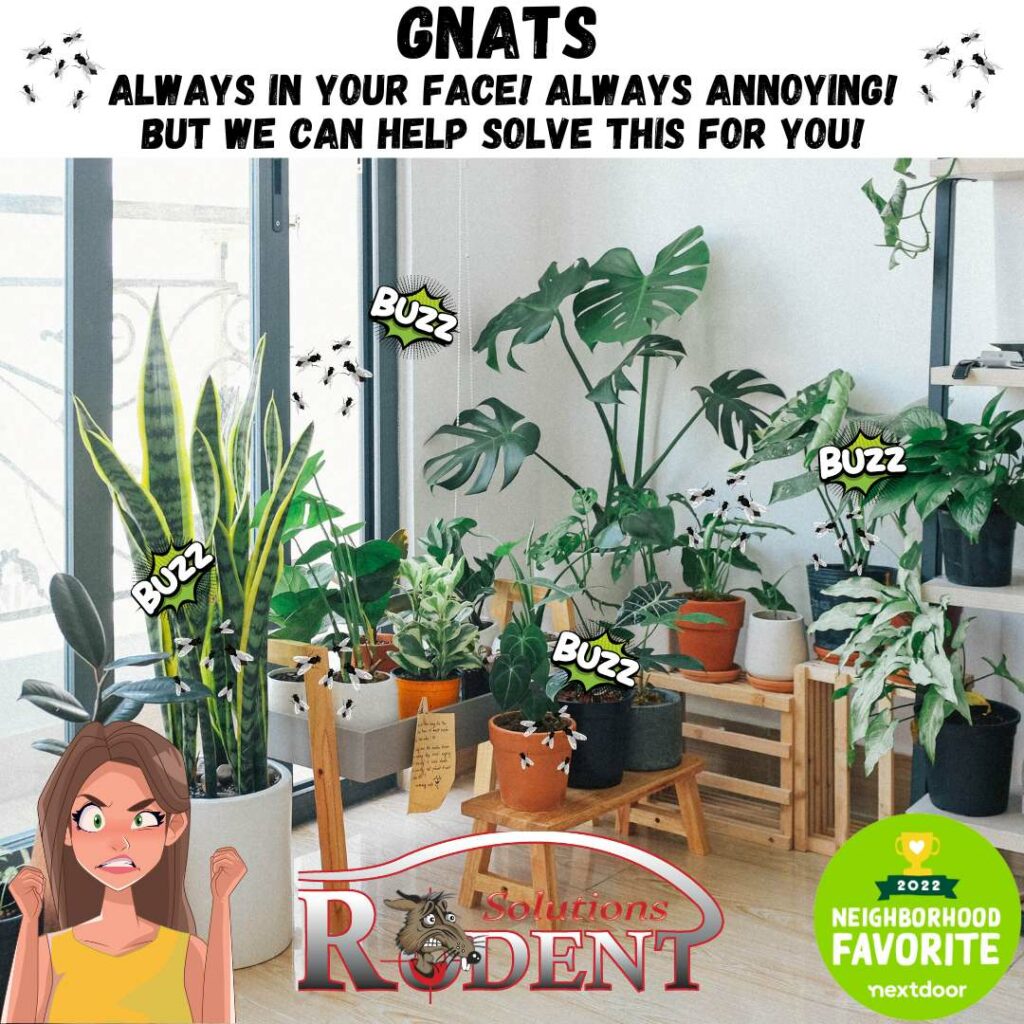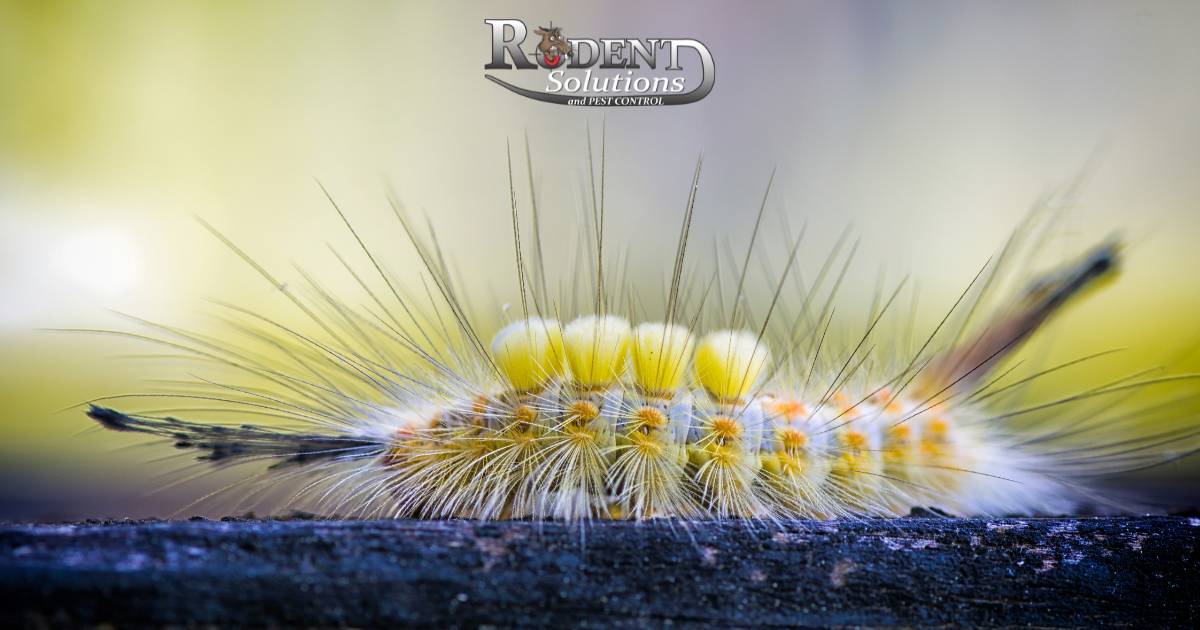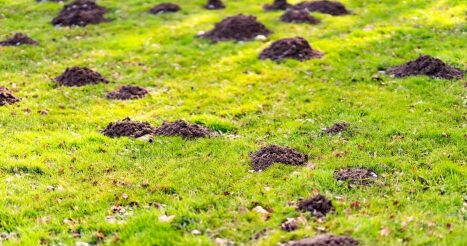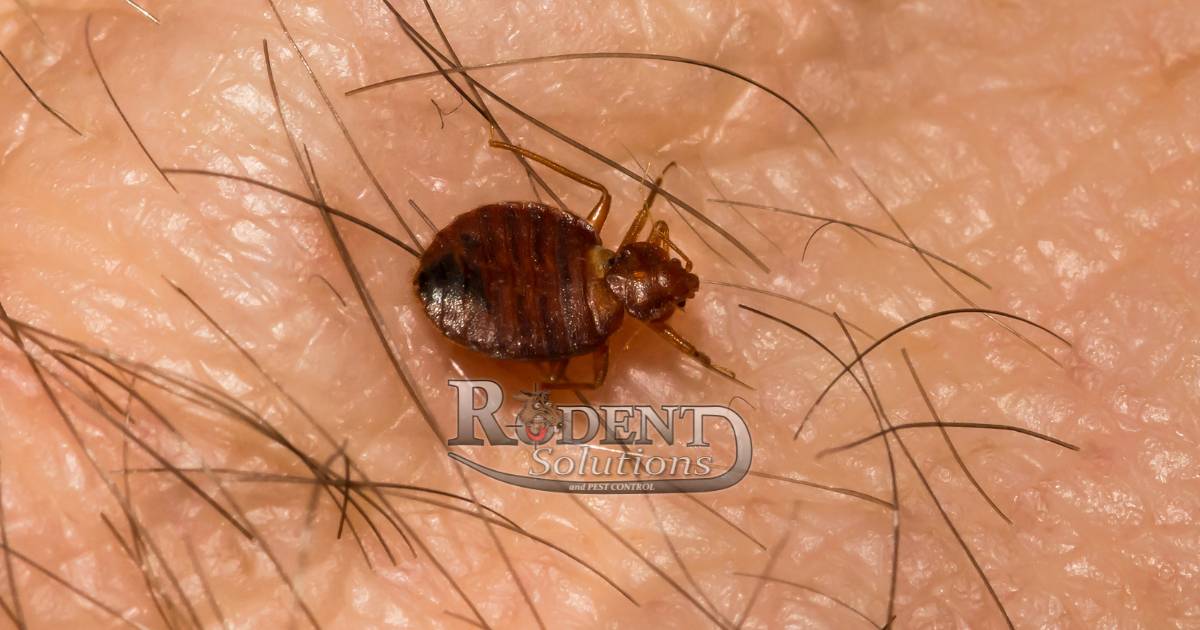Gnats are tiny flying insects often found hovering around lights or plants. They are a nuisance to many people, especially during the warmer months, and can be challenging to get rid of once they have invaded your space, leading to calling a pest control company near you. In this article, we will explore what gnats are, what they look like, their habits, what they eat, where they come from, and how to get rid of them. Nobody wants annoying gnats in their face. They can also be an issue for our commercial pest control accounts in restaurants, commercial kitchens, and grocery stores.

What are Gnats?
Gnats are a type of small fly that belongs to the Diptera order, which means they have only one pair of wings. They are typically less than 1/8 inch long and black or gray in color. Gnats are also commonly referred to as fruit flies, vinegar flies, or eye gnats. On the inside of buildings, when Gnats are found, Fruit Flies are often not far behind because they can both be caused to appear for similar reasons.
Read More About the Fruit Fly: How to Get Rid of Fruit Flies- The Ultimate Guide
What do Gnats Look Like?
Gnats have slender bodies and long, thin legs. Their wings are clear or smoky, with fine hairs. They have large, compound eyes that give them excellent vision, allowing them to navigate the air easily. They also have antennae that help them detect odors and other airborne signals. Most of that won’t matter to you because they are so small they can’t be seen without a microscope.
What are the Habits of Gnats?
Gnats are most active during the warmer months but can be indoors year-round. They are attracted to light, moisture, and decaying organic matter. Gnats are also attracted to fruit and other sweet substances, often found near fruit bowls or open food containers. They are social insects that may congregate in large numbers. Gnats are attracted to light because they use it to navigate. They have evolved to use the moon and stars to orient themselves in the dark.
Breeding and Reproduction of Gnats
Gnats have a short lifespan, typically ranging from two to four weeks. Female gnats lay their eggs in damp soil or decaying organic matter, such as rotting fruit or vegetables. The eggs hatch into larvae, which feed on bacteria and fungi in the surrounding environment. The larvae pupate and emerge as adult gnats after several days to weeks.

What do Gnats Eat?
Gnats are omnivores, which means that they eat both plants and animals. They feed on nectar, pollen, other sweet substances, small insects, and arthropods. Gnats are also attracted to decaying organic matter, such as fruit, vegetables, and compost. They are often found near stacks of fruit in grocery stores and near sink and floor drains in commercial kitchens and restaurants.
Where do Gnats Come From?
Gnats can come from various sources but often from decaying organic matter. This could be anything from overripe fruit to dirty dishes or even a clogged drain or dirty drain. Gnats can also come from the soil, especially if it is moist and contains organic matter. Once gnats find a suitable breeding ground, they will lay their eggs and quickly multiply.
Why Are Gnats Attracted to Me?
Gnats are known for their attraction to humans. There are several reasons why gnats may be drawn to you, including:
-
- Carbon dioxide: Gnats are attracted to the carbon dioxide that humans exhale. This is because carbon dioxide is a key component of the gnat’s food source, which consists of decaying organic matter.
-
- Heat and moisture: Gnats are also attracted to the heat and moisture generated by the human body. These conditions resemble the warm, damp environments where gnats typically lay their eggs and feed on decaying organic matter.
-
- Odors: Certain odors, such as those produced by sweat or perfumes, may also attract gnats to humans. This is because gnats have a strong sense of smell and are drawn to the chemicals and compounds that are present in these odors.
-
- Clothing: Dark or brightly colored clothing may also attract gnats, as these colors are similar to the colors of decaying organic matter that gnats typically feed on.
-
- Body Chemistry: Certain individuals may be more attractive to gnats than others. This may be due to differences in body chemistry, skin bacteria, or other factors that are not yet fully understood.
Do Gnats Carry Diseases?
While gnats are generally considered a nuisance rather than a serious health threat, they can carry certain health risks. For example, some gnats are known to transmit bacteria that can cause pink eye, although the risk of transmission is low.
Interesting Facts about Gnats
-
- The lifespan of a gnat is only a few weeks, but they can lay hundreds of eggs during that time, increasing the need for timely pest control treatment.
-
- Gnats are often used in scientific research because they have a short lifespan and are easy to breed in the lab.
-
- Female gnats lay their eggs in damp soil or decaying organic matter, and the larvae feed on bacteria and fungi.
-
- There are over 6,000 species of gnats in the world, and they can be found in nearly every habitat on Earth, from deserts to rainforests.
-
- The word “gnat” comes from the Old English word “gnæt,” which means “gnawing.”
- Some species of gnats, such as the fungus gnat, are considered beneficial because they help break down decaying organic matter and improve soil health.
- Gnats are sometimes confused with mosquitos but do not bite or feed on blood
How to Kill and Get Rid of Gnats
Getting rid of gnats inside a home can be a challenge for homeowners. It is a typical call for our pest control company near Bradenton, Lakewood Ranch, Sarasota, and the Parrish area. As with many pest control issues, the solution starts with sanitation. Here are some tips to help eliminate these pesky insects from your home:
-
- Clean up any decaying organic matter, including removing overripe fruit, dirty dishes, and other organic matter that may attract gnats.
- Keep your drains clean: Make sure your drains are free of debris and are flowing correctly. You can use vinegar and baking soda to clean your drains naturally. If that doesn’t work, we at Rodent Solutions have special products that will break down organic build-up and kill any existing gnats.
- Cover your trash: Make sure your trash cans have tight-fitting lids and are emptied regularly. Clean them to ensure spilled waste isn’t permitted to sit and cause new breeding grounds for Gnats
- Sticky Traps: You can purchase sticky traps designed to attract and trap gnats with a pheromone. These traps are an effective way to capture and eliminate gnats without using chemicals.
- Light Traps: Another type of trap is a light trap, which uses ultraviolet light to attract gnats. These traps are typically placed in dark areas, such as closets or storage rooms, and effectively capture gnats attracted to the light. Once the gnats come into contact with the trap, they are either electrocuted or trapped in a sticky adhesive.
- Attractant Traps: Traps that use vinegar or other food-based attractants to lure gnats to the trap. These traps typically use a container filled with vinegar or a mixture of vinegar and other food-based ingredients, such as sugar or fruit juice, to attract gnats. Once the gnats enter the trap, they cannot escape and eventually drown in the liquid.
- Natural repellents: Essential oils such as peppermint, lavender, and eucalyptus can effectively repel gnats. You can use a diffuser to distribute the oil throughout your home or create a spray by diluting the oil in water. You can also use neem oil, a natural pesticide derived from the neem tree. Neem oil is effective against various pests, including gnats, and can be applied directly to the soil or sprayed onto the leaves of your plants.
- Upgrade Your Screens: Have special screens installed on your patios, entryways, pool cages, and garage doors to prevent gnats from being able to enter. We recommend calling the Motorized Screen Specialists at 3/8 & Co. for custom applications to help keep you gnat free while still enjoying the natural air.
- Eliminate the Source: Situations may vary, but we prefer eliminating the source of the gnats. The goal should be to prevent them in the first place, not to catch or repel them repeatedly
- Let The Soil Dry: If you prefer to take a natural approach to control gnats in your plants, there are several remedies that you can try. One of the simplest is to allow the soil to dry out completely between watering. Gnats thrive in moist environments, so allowing the soil to dry out can help to eliminate their breeding grounds.
- Many of these steps will also help you prevent an infestation of fruit flies. Click the link below for more information.
- Read More: How To Get Rid of Fruit Flies- The Ultimate Guide
Chemical Solutions for Controlling & Killing Gnats
- Pesticides: If natural remedies don’t work, or if you prefer a more aggressive approach, several chemical solutions can effectively control gnats in plants. One option is to use a commercial pesticide specifically formulated to target gnats. These pesticides can be applied directly to the soil or sprayed onto the leaves of your plants. It’s best to let an exterminator near you apply these products for proper selection.
- Soil Drench: Another option is to use a soil drench, a liquid solution poured directly onto the soil. Soil drenches are effective against gnats because they penetrate the soil and target the larvae responsible for the most damage to plants.
Preventing Future Gnat Infestations
- Overwatering: Once you’ve successfully eliminated a gnat infestation, it’s essential to take steps to prevent future infestations from occurring. One of the simplest ways to do this is to avoid overwatering your plants. As we mentioned earlier, gnats thrive in moist environments, so allowing the soil to dry out between watering can help to keep them at bay.
- Special Soil Mix: You can also try using a soil mix that contains perlite or vermiculite, which helps improve drainage and prevents soil from becoming too moist.
- Clean up: Additionally, clean up any dead leaves or other plant debris that may accumulate in your pots, as this can provide a breeding ground for gnats.
At Rodent Solutions, as the two-time winners of Nextdoor’s Favorite Pest Control Company, our extermination services can handle these gnat issues for you. However, by taking steps to eliminate their breeding grounds, you can often effectively get rid of gnats in your home. While gnats may seem like a minor annoyance, they are an essential part of the ecosystem and play a role in breaking down decaying organic matter. As with any insect, it is essential to respect their place in the natural world and strive for a balance between control and preservation.

Pest/Wildlife Control 15 Years
Construction for 13 Years
Pest Control License JB299099
Wildlife License LW203605
Pest Management University: Founders and Masters
AAS Degree in Drafting Design with a Concentration in Building Construction
NWCOA Member (National Wildlife Control Operators Association)
NWCOA Rodent Standard Certified
NWCOA Bat Standard Certified
NCWOA Certified Urban Bird Management Operator
NWCOA Zoonotic Disease Standard Certified
Member of the National Pest Management Association (NPMA)
Bird Barrier Certified Installer
Bird-B-Gone Authorized Installer
OSHA 10 Training Completed for the Construction Industry
Aerial Lift Certified
Fall Protection Certified




